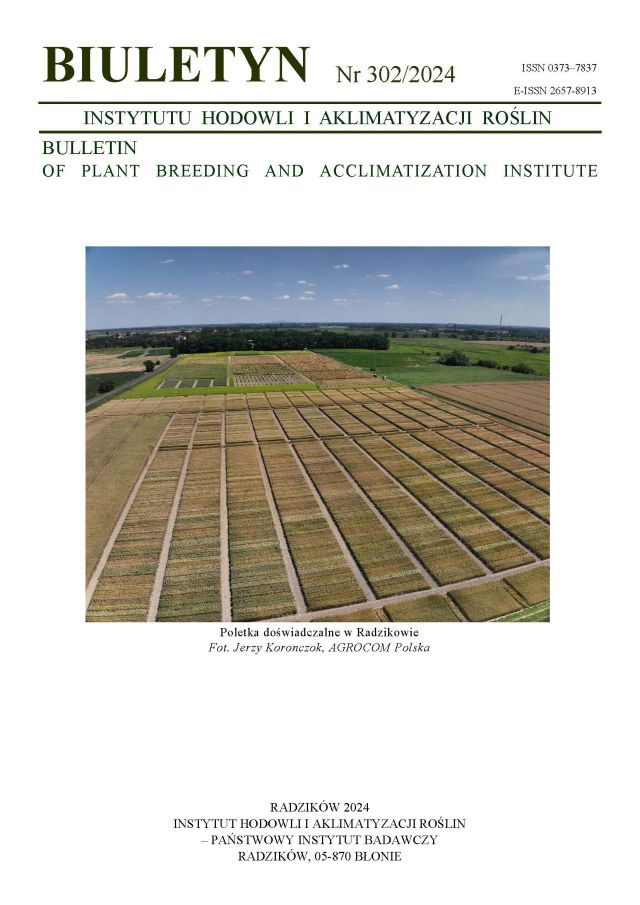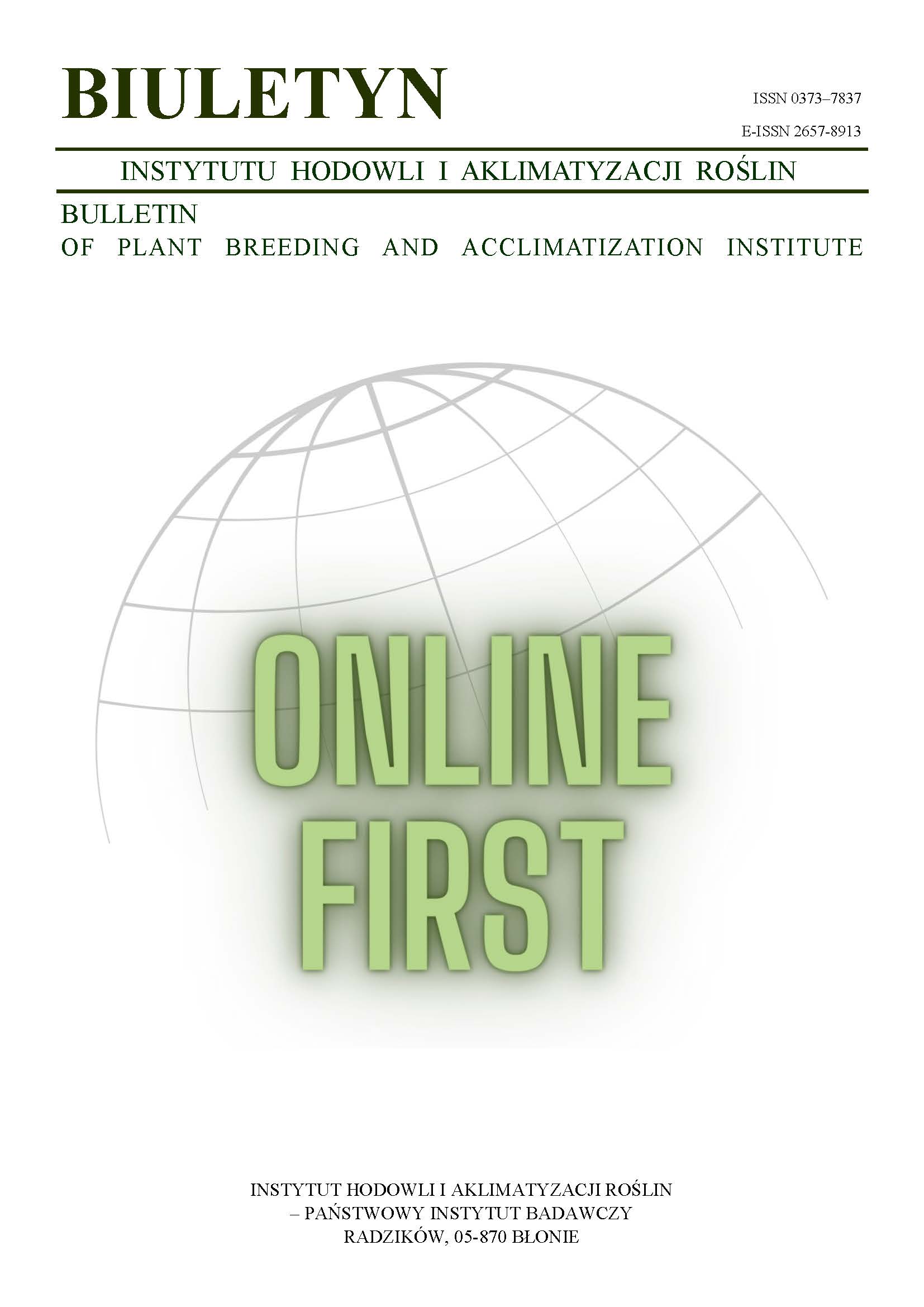General and Specific Combining Ability for Fruit Yield Using Diallel Population of Ridge Gourd (Luffa acutangula (Roxb.) L.)
K. Naher Ruma
Department of Genetics and Plant Breeding, Bangabandhu Sheikh Mujibur Rahman Agricultural University Gazipur-1706 (Bangladesh)
M. S. Raihan
Department of Genetics and Plant Breeding, Bangabandhu Sheikh Mujibur Rahman Agricultural University Gazipur-1706 (Bangladesh)
M. A. Hoque
Department of Horticulture, Bangabandhu Sheikh Mujibur Rahman Agricultural University Gazipur-1706 (Bangladesh)
A. K. M. Aminul Islam
aminulgpb@bsmrau.edu.bda:1:{s:5:"pl_PL";s:57:"Bangabandhu Sheikh Mujibur Rahman Agricultural University";} (Bangladesh)
Abstrakt
An experiment was conducted using 7 x 7 diallel population of ridge gourd to study the general and specific combining ability (GCA and SCA) of parents and their hybrids for 17 yield traits in a randomized complete block design with three replications. Data on 17 characters were subjected to analysis of GCA and SCA variances and their effects. The GCA and SCA variance were found highly significant for all the characters except days to first female flowering. Low magnitude of σ²g/σ²s ratio was observed for all the traits other than days to first male flowering, days to first female flowering, fruit length (cm), fruit width (mm), individual fruit weight (g). On the other hand, σ²g/σ²s ratio was more than 1.0 for days to first male flowering, days to first female flowering, fruit length (cm), fruit width (mm) and individual fruit weight (g). The general combining effects (GCA) of the parents revealed that none of the parent was found to be good general combiner for all the characters. However, in the present investigation, parent P3 was observed to be one of the best general combiner as it has shown significant GCA effects in desirable direction for number of fruits per plant and fruit yield per plant. It also observed significant GCA effects for parameters related to earliness viz., days to first male flowering, node number of first female flower and days to first harvest. Similarly, parent P5 was also good general combiners for fruit length, fruit width and individual weight of fruit, parent P6 and P7 were also good general combiners for fruit length, individual weight of fruit except fruit width. The parent P2 and P4 were also good general combiners for number of fruits per plant. The estimate of SCA effects revealed that none of the crosses was consistently superior for all the characters. The highest yielding hybrid (P3 x P4) had registered the highest SCA effect for fruit yield per plant. Similarly, the cross combinations P6 x P7, P3 x P6, P3 x P7, P1 x P5, P2 x P6, P4 x P5 were observed as good specific combinations for fruit yield per plant. The hybrid P2 x P6 was good specific combiner for days to first male flowering, hybrid P3 x P4 for sex ratio followed by P4 x P5 and P5 x P7. Hybrid P1 x P4, P6 x P7, P3 x P6 and P2 x P4 were found as good specific combinations for fruit length, P4 x P6 and P3 x P4 for fruit width. The hybrids P3 x P6, P6 x P7, P3 x P4, P2 x P4 and P1 x P5 were observed as good specific combinations for individual fruit weight.
Słowa kluczowe:
Ridge gourd (Luffa acutangula), hybrids, σ²g/σ²s ratio, GCA, SCA, fruit yieldBibliografia
BARI, 2019. Krishi projukti hatboi (Handbook on Agro-Technology), 8th edition, 168.
Google Scholar
BBS, 2020. Statistical year book (2019). Bangladesh Bureau of Statistics, Ministry of Planning, Government of Bangladesh. Dhaka, Bangladesh.
Google Scholar
Biabani, A, Rafii, M. Y., Saleh, G., Shabanimofrad, M., Latif, M. A., 2012. Combining ability analysis and evaluation of heterosis in Jatropha curcas L. F1-hybrids. Australian Journal of Crop Science, 6, 1030-1036.
Google Scholar
Bidhendi, M.Z., Choukan, R., Darvish, F., Mostafavi, K., Hervan, E.M., 2011. Determination of combining abilities and heterotic patterns of fourteen medium to late maturing Iranian maize inbred lines using diallel mating design. African Journal of Biotechnology, 10, 16854-16865.
Google Scholar
Brammer, H., 1971. Soil resources soil survey project, Bangladesh. AGL: SFPac.6. Technical report 3.
Google Scholar
Cockerham, C. C., 1961. Implications of genetic variances in a hybrid breeding program. Crop Sci, 1(1), 47-52.
DOI: https://doi.org/10.2135/cropsci1961.0011183X000100010015x
Google Scholar
Dabholkar, A. R., 1992. Elements of biometrical genetics. Concept Publishing Company, New Delhi, India, 138-140.
Google Scholar
Dandge, V.S., Rothe, S.P., Pethe, A.S., 2010. Antimicrobial activity and pharmacognostic study of Luffa acutangula Roxb var amara on some deuteromycetes fungi. Int J Sci Inn Discover, 2(1), 191-196.
Google Scholar
Deshpande, M.R., 2010. Genetic studies of fruit yield and its components by line x tester analysis in ridge gourd (Luffa acutangula (Roxb.) L.). Unpublished M.Sc. (Agri.) thesis submitted to Anand Agriculture University, Anand.
Google Scholar
Griffing, B., 1956. Concept of general and specific combining ability in relation to diallel crossing systems. Australian Journal of Biological Sciences, 9, 463-493.
DOI: https://doi.org/10.1071/BI9560463
Google Scholar
Jadav, K., Sapovadiya, M.H., 2018. Combining ability for fruit yield and its component traits in ridge gourd (Luffa acutangula (Roxb.) L.). The Pharma Innovation Journal, 7(9), 62-66.
Google Scholar
Kadam, P.Y., 1989. Heterosis studies in ridge gourd (Luffa acutangula (Roxb.) L.). Ph.D. Thesis, Mahtma Phule Krishi Vidyapeeth, Rahuri, India.
Google Scholar
Kalloo, G., Bergh, B.O., 1993. Loofah-Luffa spp. In: Genetic improvement of vegetable crops (eds.), Pergamon Press, 265-266.
DOI: https://doi.org/10.1016/B978-0-08-040826-2.50023-0
Google Scholar
Kamble, D.S., Gasti, S.D.V., Evoor, S., Masuthi, D.K.A., Koulagi, S., 2018. Combining ability in ridge gourd (Luffa acutangula (Roxb.) L.). International Journal of Current Microbiology and Applied Sciences, 7(12), 567-577.
DOI: https://doi.org/10.20546/ijcmas.2018.712.071
Google Scholar
Kandoliya, U.K., Marviya, G.V., Bodar, N.P., Bhadja, N.V., Golakiya, B.A., 2016. Nutritional and antioxidant components of ridge gourd (Luffa acutangula (Roxb.) L.) fruits of promising genotypes and varieties. Scholars Journal of Agriculture and Veterinary Sciences, 3(5), 397-401.
Google Scholar
Lodam, V.A., Desai, D.T., Khandelwal, V., Patil, P.P., 2009. Combining ability analysis in ridge gourd (Luffa acutangula (Roxb.) L.). Vegetable Science, 36(1), 113-115.
Google Scholar
Manikandaselvi, S., Brindha, P., 2014. Quality control studies on Luffa acutangula L. Int J Pharm Pharm Sci, 6 (1), 55-62.
Google Scholar
Mather, K., Zinks, J.L., 1982. “Biometrical Genetics” (3rd Edn). Chapman and Hall Ltd., London.
DOI: https://doi.org/10.1007/978-1-4899-3406-2
Google Scholar
Muthaiah, K., Gasti V.D., Mallesh, S., Das, A., Mangi V., 2017. Combining ability studies for early and yield traits in ridge gourd (Luffa acutangula (Roxb) L.). International Journal of Agriculture Sciences, 9(26), 4319-4321.
Google Scholar
Naransaver, A.R., Gasti, V.D., Shantappa, T., Mulge, R., Allolli, T.B., Thammaiah, N., 2014. Heterosis studies in ridge gourd (Luffa acutangula (Roxb.) L.). Karnataka Journal of Agricultural Science, 27(1), 47-51.
Google Scholar
Prabhakar, B.N., 2008. Combining ability and heterosis for fruit yield and yield components in ridge gourd (Luffa acutangula (Roxb) L.). Journal Research of ANGRAU (Acharya N.G. Ranga Agricultural University), 36, 24-32.
Google Scholar
Purohit, V.L., Mehta, D.R., Dhaduk, L.K., Gajipara, N.N. 2005. Combining ability for fruit yield and its attributes in ridge gourd (Luffa acutangula (Roxb.) L.). Vegetable Science, 34(1), 84-85.
Google Scholar
Rainey, K.M., Griffiths, P.D., 2005. Diallel analysis of yield components of snap beans exposed to two temperature stress environments. Euphytica, 142, 43-53.
DOI: https://doi.org/10.1007/s10681-005-0480-3
Google Scholar
Rao, B.N., Venkata Rao, P., Reddy, Y.N., 2000. Combining ability studies in ridge gourd (Luffa acutangula (Roxb.) L.). Indian Journal of Tropical Agriculture, 18(2), 141-146.
Google Scholar
Sarkar, M., Singh, D.K., Lohani, M., Das, A.K., Ojha, S. 2015. Exploitation of heterosis and combining ability for earliness and vegetative traits in ridge gourd (Luffa acutangula (Roxb.) L.). International Journal of Agriculture, Environment and Biotechnology, 8(1), 153.
DOI: https://doi.org/10.5958/2230-732X.2015.00020.0
Google Scholar
Sharma, J.R., 1998. Statistical and biometrical techniques in plant breeding. Pune, India: New Age International (pvt.) Limited.
Google Scholar
Sharma, M., Sharma, A., Muthukumar, P., 2016. Genetic combining ability, gene action and heterosis for biochemical and antioxidant content in chili pepper. The Bioscan, 11(3), 1963-1968.
Google Scholar
Singh, A.K., Chaudhary, B.D., 1985. Biometrical Methods in Quantitative Genetic Analysis. New Delhi, India: Kalyani Publishers.
Google Scholar
Sprague, G.F., Tatum, L.A. 1942. General vs. specific combining ability in single crosses of corn 1. Agronomy Journal, 34(10), 923-932.
DOI: https://doi.org/10.2134/agronj1942.00021962003400100008x
Google Scholar
Autorzy
K. Naher RumaDepartment of Genetics and Plant Breeding, Bangabandhu Sheikh Mujibur Rahman Agricultural University Gazipur-1706 Bangladesh
Autorzy
M. S. RaihanDepartment of Genetics and Plant Breeding, Bangabandhu Sheikh Mujibur Rahman Agricultural University Gazipur-1706 Bangladesh
Autorzy
M. A. HoqueDepartment of Horticulture, Bangabandhu Sheikh Mujibur Rahman Agricultural University Gazipur-1706 Bangladesh
Autorzy
A. K. M. Aminul Islamaminulgpb@bsmrau.edu.bd
a:1:{s:5:"pl_PL";s:57:"Bangabandhu Sheikh Mujibur Rahman Agricultural University";} Bangladesh
Statystyki
Abstract views: 353PDF downloads: 71
Licencja
Prawa autorskie (c) 2024 K. Naher Ruma, M. S. Raihan, M. A. Hoque, A. K. M. Aminul Islam

Utwór dostępny jest na licencji Creative Commons Uznanie autorstwa – Na tych samych warunkach 4.0 Miedzynarodowe.
Z chwilą przekazania artykułu, Autorzy udzielają Wydawcy niewyłącznej i nieodpłatnej licencji na korzystanie z artykułu przez czas nieokreślony na terytorium całego świata na następujących polach eksploatacji:
- Wytwarzanie i zwielokrotnianie określoną techniką egzemplarzy artykułu, w tym techniką drukarską oraz techniką cyfrową.
- Wprowadzanie do obrotu, użyczenie lub najem oryginału albo egzemplarzy artykułu.
- Publiczne wykonanie, wystawienie, wyświetlenie, odtworzenie oraz nadawanie i reemitowanie, a także publiczne udostępnianie artykułu w taki sposób, aby każdy mógł mieć do niego dostęp w miejscu i w czasie przez siebie wybranym.
- Włączenie artykułu w skład utworu zbiorowego.
- Wprowadzanie artykułu w postaci elektronicznej na platformy elektroniczne lub inne wprowadzanie artykułu w postaci elektronicznej do Internetu, lub innej sieci.
- Rozpowszechnianie artykułu w postaci elektronicznej w internecie lub innej sieci, w pracy zbiorowej jak również samodzielnie.
- Udostępnianie artykułu w wersji elektronicznej w taki sposób, by każdy mógł mieć do niego dostęp w miejscu i czasie przez siebie wybranym, w szczególności za pośrednictwem Internetu.
Autorzy poprzez przesłanie wniosku o publikację:
- Wyrażają zgodę na publikację artykułu w czasopiśmie,
- Wyrażają zgodę na nadanie publikacji DOI (Digital Object Identifier),
- Zobowiązują się do przestrzegania kodeksu etycznego wydawnictwa zgodnego z wytycznymi Komitetu do spraw Etyki Publikacyjnej COPE (ang. Committee on Publication Ethics), (http://ihar.edu.pl/biblioteka_i_wydawnictwa.php),
- Wyrażają zgodę na udostępniane artykułu w formie elektronicznej na mocy licencji CC BY-SA 4.0, w otwartym dostępie (open access),
- Wyrażają zgodę na wysyłanie metadanych artykułu do komercyjnych i niekomercyjnych baz danych indeksujących czasopisma.
Inne teksty tego samego autora
- M. Sakibur Alam, M.S. Raihan, M.M. Haque, A. K. M. Aminul Islam, Heterosis for Seed Yield Related Traits in Brassica napus L. Hybrids - Preliminary Studies , Biuletyn Instytutu Hodowli i Aklimatyzacji Roślin: Nr 302 (2024): Wydanie regularne














